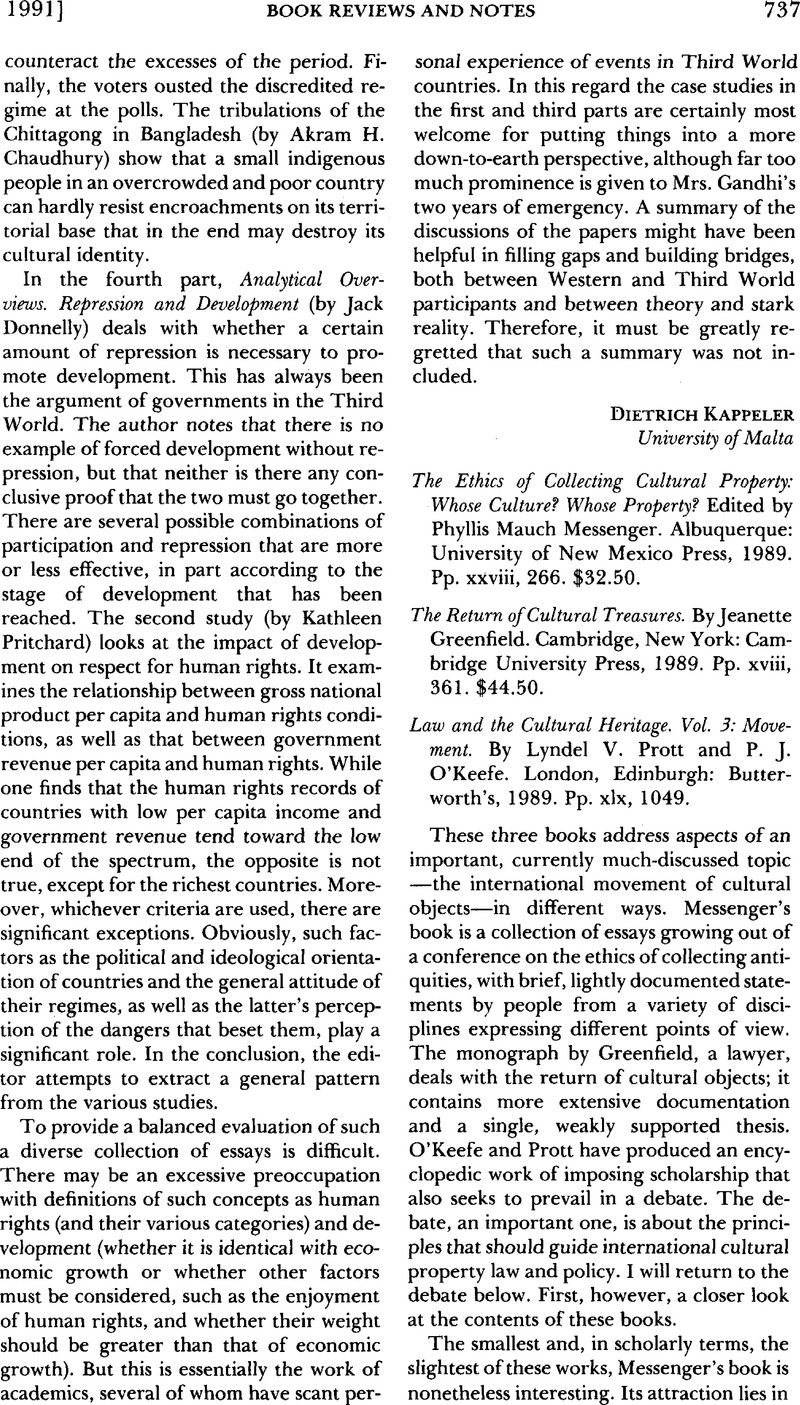No CrossRef data available.
Article contents
The Ethics of Collecting Cultural Property: Whose Culture? Whose Property? Edited by Phyllis Mauch Messenger. Albuquerque: University of New Mexico Press, 1989. Pp. xxviii, 266. $32.50. - The Return of Cultural Treasures. By Jeanette Greenfield. Cambridge, New York: Cambridge University Press, 1989. Pp. xviii, 361. $44.50. - Law and the Cultural Heritage. Vol. 3: Movement. By Lyndel V. Prott and P. J. O’Keefe. London, Edinburgh: Butterworth’s, 1989. Pp. xix, 1049.
Published online by Cambridge University Press: 27 February 2017
Abstract

- Type
- Book Reviews and Notes
- Information
- Copyright
- Copyright © American Society of International Law 1991
References
1 For a revealing sample of the professional archaeologists’ view of collectors and dealers, see Ricardo J. Elia, Popular Archaeology and the Antiquities Market: A Review Essay, 18 J. Field Archaeology 95 (1991).
2 See particularly W. St. Clair, Lord Elgin and the Marbles (rev. ed. 1983); Smith, Lord Elgin and His Collection, 36 J. Hellenic Stud. 163 (1916); J. Rothenberg, “Descensus ad Terram”: The Acquisition and Reception of the Elgin Marbles (1977); T. Vrettos, A Shadow of Magnitude: The Acquisition of the Elgin Marbles (1974); Merryman, Thinking about the Elgin Marbles, 83 Mich. L. Rev. 1881 (1985).
3 This error is noted by Ellen Herscher in her review of Messenger in Museum News, May/June 1990, at 89, 91.
4 The decision of November 19, 1990, by the Council of Ministries of Culture of the Community (reported in ARTnewsletter, Dec. 11, 1990, at 5), which significantly defers to national cultural property retention laws, came much too late for inclusion in Greenfield’s book, but it culminates a discussion that began much earlier and has far more relevance to the topic than the isolated decision of the European Court of Justice to which Greenfield refers.
5 India v. Bumper Development Corp., No. 85-NJ 4731 (Q.B. Feb. 17, 1988).
6 United States v. McClain, 593 F.2d 658 (5th Cir. 1979).
7 678 F.2d 1150 (2d Cir. 1982).
8 917 F.2d 278 (7th Cir. 1990).
9 702 F.Supp. 810 (CD. Cal. 1989). Peru lost. The case is on appeal as this is written.
10 The case awaits trial as this is written. See William H. Honan, Judge Clears Way for Trial over Turkish Art at Met, N.Y. Times, July 20, 1990, at A25.
11 The best and fullest statement of this position is Bator, An Essay on the International Trade in Art, 34 Stan. L. Rev. 275 (1982), republished as P. M. Bator, The International Trade in Art (1982). My published efforts include: Hot Art—A Reexamination of the Illegal International Trade in Cultural Objects (with A. E. Elsen), 12 J. Arts Mgmt. & L. 5 (1982), republished in International Institute of Higher Studies in Criminal Sciences, The Penal Protection of Works of Art 151 (1983); Thinking about the Elgin Marbles, 83 Mich. L. Rev. 1881 (1985); Two Ways of Thinking about Cultural Property, 80 AJIL 831 (1986); The Retention of Cultural Property, 21 U.C. Davis L. Rev. 477 (1988); The Public Interest in Cultural Property, 77 Cal. L. Rev. 339(1989).




